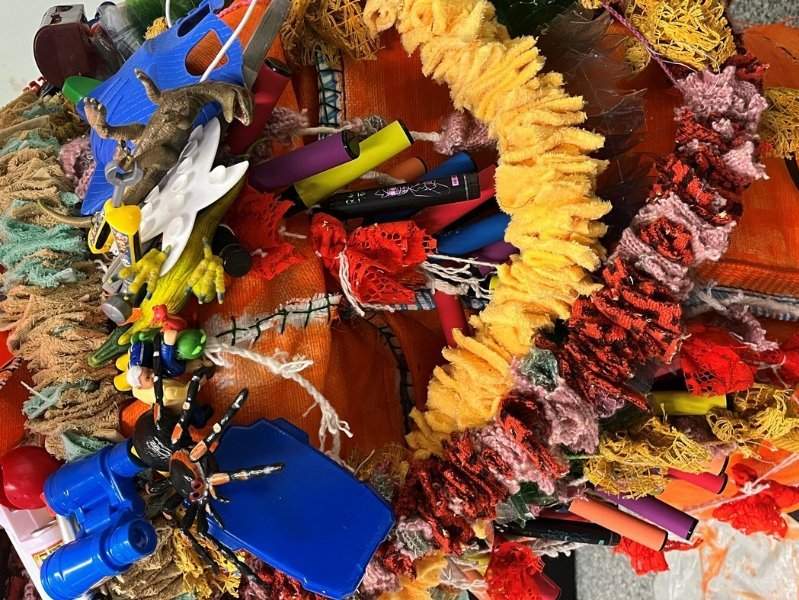Diplomatic immunity: in Lugano, Pedro Wirz's work on immutable class prerogatives
From June 4 to July 23 in Lugano , the Palazzo Reali room of MASI - Museo d’Arte della Svizzera Italiana welcomes Diplomatic Immunity, the project by Brazilian artist Pedro Wirz (Pindamonhangaba, 1981) winner of the 2023 edition of the Bally Artist Award. A resident of Zurich, the artist won the prestigious award with work that questions class prerogatives, hierarchical power, and the archetypal and immutable positions of society. Positions that in Wirz’s installation take shape in 12 sculptures of various sizes that refer to positions of leadership - a king, a president, a pope, a rabbi, etc. - each of which reflects a particular hierarchy of power, whether economic, religious, political or socio-cultural.
In contrast to the supposed role of power, the sculptures are made from the remains of the most diverse materials, collected by the artist in his studio. An approach, this one inspired by the Merzbau of constructivist artist Kurt Schwitters, and thus by the idea of assemblage and precarious sculpture. At the same time, the method of accumulation refers to capitalism’s cycles of continuous growth and exhaustion, while the precarious aesthetic recalls symbols of power that have fallen into ruin.
The stigmatization of power figures is also reflected in Pedro Wirz’s installation in the very configuration of the 12 busts in the space, which stems from the artist’s research on important meetings such as the G7, the Club of Rome or the Last Supper in the biblical narrative. Visitors to the exhibition have barely enough space to move around, while the busts become almost obstacles to be carefully avoided. Even with its physical presence, the work thus expresses the dichotomy between competition and cooperation and questions the meaning of a “more sustainable society,” which is often viewed from an exclusively economic perspective.
“To undertake a more sustainable existence,” Wirz explains, “we have to confront the realities and difficulties of living together. We must go far beyond our lives, our desires and our vanity, and even beyond the legacy of a family name, or the principles promoted by religious leaders or mythological figures. We need to think not as individuals but as species, that is, as inhabitants of the earth, as earthlings, as living beings meant to coexist simultaneously and respectfully.”
Also on display are three wall reliefs, which belong to a series begun in 2019 with which the artist investigates the links between the organic, synthetic realm and technological realities and how their contamination is altering the environment in an ongoing battle between extinction and renewal. This transformation of ecosystems due to human (technological) intervention in the natural landscape is depicted through the subjects and materials of the reliefs, while the rectangular box shape metaphorically evokes television screens or smartphones, but also human-sized tombstones.
Pedro Wirz takes inspiration from cultural history, science, crafts and folklore. Recent solo exhibitions include those at PHILIPPZOLLINGER (Zurich, 2023); Kai Matsumiya (New York, 2022); Kunsthalle Basel (2022); Marc Selwyn (Los Angeles, 2020); Galerie Nagel Draxler (Berlin, 2019); Centre Culturel Suisse (Paris, 2019); Kunsthaus Langenthal (2019); LongTang (Zurich, 2019); and Instituto Tomie Ohtake (São Paulo, 2017). Wirz has, in addition, been included in numerous group exhibitions, such as at Centre d’Art Contemporain Genève (2023); Aargauer Kunsthaus (2019); Centre Pasquart (2018); Blank Projects (Cape Town, 2018); Tinguely Museum (Basel, 2016); CCS Bard Hessel Museum of Art (New York, 2015); Künstlerhaus Stuttgart (2013); Dortmunder Kunstverein (2013); Palais de Tokyo (Paris, 2013); and Kunsthalle Basel (2011).
Image: Pedro Wirz, Diplomatic Immunity, detail (2023; 12 sculptures, reclaimed studio materials on plinth, dimensions variable). Courtesy of the artist, Galerie Nagel Draxler and PHILIPPZOLLINGER gallery.
 |
| Diplomatic immunity: in Lugano, Pedro Wirz's work on immutable class prerogatives |
Warning: the translation into English of the original Italian article was created using automatic tools. We undertake to review all articles, but we do not guarantee the total absence of inaccuracies in the translation due to the program. You can find the original by clicking on the ITA button. If you find any mistake,please contact us.





























